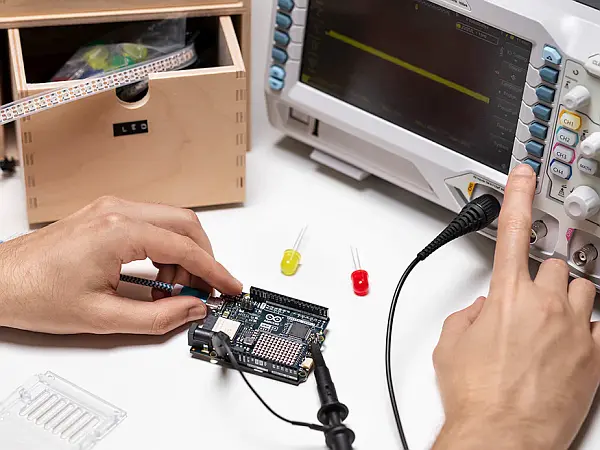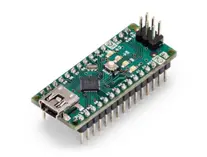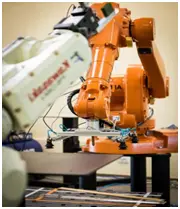Are you an electronics pro? A newly-minted hobbyist? Maybe something in between? Regardless of where you fall along the spectrum, odds are you’ve probably at least heard about Arduino before. It has grown over the years to become the gold standard of device development, its tools and circuit boards known equally for their innovation and ready accessibility.

Nothing short of revolutionary, it has changed the world of embedded systems for the better and helped empower the makers and educators of our world to bring their ideas to life. Why has Arduino made such a big impact, though, and how does it function? Read along to learn about the ins and outs of the Arduino platform and what you could gain from it.
What is Arduino?
 Arduino, often dubbed as the “brain” of embedded electronics projects, is an open-source platform used to help build a variety of electronic devices. The platform is comprised of both software and hardware - a programmable microcontroller and an Integrated Development Environment (IDE) - and, unlike many other circuit boards on the market, does not require a separate programmer. This allows developers to quickly write and upload code straight from their computer to the microcontroller.
Arduino, often dubbed as the “brain” of embedded electronics projects, is an open-source platform used to help build a variety of electronic devices. The platform is comprised of both software and hardware - a programmable microcontroller and an Integrated Development Environment (IDE) - and, unlike many other circuit boards on the market, does not require a separate programmer. This allows developers to quickly write and upload code straight from their computer to the microcontroller.
To break it down to the basics, an Arduino board is essentially a small computer that’s programmed to perform specific tasks. Its microcontroller (which we’ve gone in-depth about before!) acts as the brains of the board, taking written code and turning it into actionable instructions. Pretty familiar stuff, right?
However, the interesting thing about this is that the microcontroller is actually pre-programmed with a bootloader - a little piece of software residing on the circuit board that allows it to receive code through a simple USB connection.
Arduino’s IDE, on the other hand, is what’s used to write, compile, and upload said code. It even utilizes a simplified version of C++ programming to do so, making it accessible to beginner programmers while ensuring plenty of powerful features remain for more advanced ones.
How Arduino Works
The basics of Arduino are simple enough: users write code using the IDE, the microcontroller executes it, and the device does what it’s told. Yet, how this works in practice is significantly more complicated than one might believe. There’s a lot going on under the hood that few really see!
At their core lies the microcontroller, which, as previously explained, turns code into actionable instructions and controls the behavior of connected hardware. Another component called a clock crystal or crystal oscillator is essential to this process, generating the clock signal needed for the microcontroller to execute time-sensitive operations.
Beyond this are a ton of different input/output pins, both digital and analog. Typically arranged around the board’s edges, these pins “talk” to external components such as sensors, actuators, and other peripherals. They then act as a middleman for the MCU, providing the signals needed to interface with these external devices.
But none of this can be accomplished without the proper power flow - that’s where the voltage regulator comes in.
These components do precisely what you’d expect and ensure that the Arduino board’s MCU and connected peripherals don’t get too much or too little power. It allows the board to accept a range of input voltages and, thus, makes it compatible with all sorts of power sources, from battery power to USB.
Speaking of USB, since one of Arduino’s major selling points is that developers can upload code via a USB connection, these boards make a point of specifically including a designated interface for it. Although, it’s not only beneficial for programming. The USB interface also facilitates other kinds of data exchange with external devices.
Surprised yet by how much goes into making the Arduino work? This isn’t even everything. Arduino circuit boards also feature various power inputs, a power LED indicator, TXRX LEDs, a reset button to restart the MCU for debugging/iteration purposes, plus more - and all to improve the developer experience!
Real-world Applications of Arduino
Arduino’s unique dual hardware/software approach and attention to detail has seriously shifted how people develop electronics. It’s made things faster, easier, and more versatile. It’s no wonder Arduino boards have seen widespread adoption across so many industries.
Interested in how some have put it to good use? Here are just a few of the real-world applications seen by the platform:
 Robotics. If you’ve ever wondered what’s behind some of the essential machines we’ve seen leveraged in production spaces, it’s often Arduino. The open-source platform is ideal for powering robotic arms and industrial control systems, providing controls for motors, sensors, actuators, and all other manner of peripherals. However, Arduino-based solutions see use in things like surveillance drones and exploration robots, too!
Robotics. If you’ve ever wondered what’s behind some of the essential machines we’ve seen leveraged in production spaces, it’s often Arduino. The open-source platform is ideal for powering robotic arms and industrial control systems, providing controls for motors, sensors, actuators, and all other manner of peripherals. However, Arduino-based solutions see use in things like surveillance drones and exploration robots, too!- IoT and Home Automation: Arduino is great for industrial purposes but is just as valuable within home devices. Indeed, it’s the drive behind many of the IoT and automated projects we use every day. It has helped in creating smart thermostats, home security systems, smart wearables, and beyond.
- Education: Crafting modern devices is an art that’s difficult to teach, though Arduino’s user-friendly language and extensive documentation go a long way to simplifying things. This is why it’s a valuable teaching tool often used in schools and universities. A good starting point for instructors, it also allows students to get hands-on experience and dive into the thick of electronics programming earlier in their education.
- Environmental Monitoring: Academic scholars are often taught with Arduino, yet scientists often get in on the action. Science-centric researchers can work with Arduino systems for environmental monitoring applications like water quality sensors and weather stations. The platform’s data collection and analysis capabilities make it a natural fit.
- Medical Devices: Medicine and technology are inherently intertwined, especially in this day and age. Arduino is one tool that joins them together beautifully. It finds application in a myriad of monitors, limb prosthetics, and other assistive tech. Since the platform offers a lot of flexibility, Arduino-based medical devices can easily be tailored to patients’ specific needs and capabilities.
The Benefits of Arduino
Applied in seemingly every industry, by everybody, Arduino is a kind of giant in the electronics development world. A powerful platform with a now-powerful name, it makes sense for many folks to immediately adopt it as their project solution of choice.
But what if you’re still on the fence? Below are some of the benefits you might get by going with Arduino as the basis for your new biggest and brightest device:
- Low-cost. Hoping to build on a budget? Choosing an Arduino board is one of your best bets to keep prices low without sacrificing functionality. They’re relatively affordable, high-quality, and come in several varieties to ensure you only pay for what you need.
- Even if you’re a total professional, nobody wants to put more time and effort into something if they don’t have to. And Arduino’s a perfect pick for those who firmly espouse the “work smarter, not harder” mentality. They’re super accessible thanks to their simplified programming/documentation and plug-in-play operation. As a bonus, they even come in full kits and pre-assembled modules in case you don’t want to put in the time.
- Cross-Platform. Find yourself firmly entrenched in the Apple ecosystem, or perhaps you hold that PC is always best? Either way, Arduino has you covered. The boards and software work with both operating systems alongside Linux, so compatibility is never an issue.
- Solid Community Support. Even the best developers and devices run into snags sometimes. You get stuck on a project, a component suddenly doesn’t want to cooperate - whatever the issue may be, Arduino has a community ready to lend a hand. Resources, tutorials, and forums filled with knowledge are always just a couple of clicks or taps away.

 Robotics. If you’ve ever wondered what’s behind some of the essential machines we’ve seen leveraged in production spaces, it’s often Arduino. The open-source platform is ideal for powering robotic arms and industrial control systems, providing controls for motors, sensors, actuators, and all other manner of peripherals. However, Arduino-based solutions see use in things like surveillance drones and exploration robots, too!
Robotics. If you’ve ever wondered what’s behind some of the essential machines we’ve seen leveraged in production spaces, it’s often Arduino. The open-source platform is ideal for powering robotic arms and industrial control systems, providing controls for motors, sensors, actuators, and all other manner of peripherals. However, Arduino-based solutions see use in things like surveillance drones and exploration robots, too!